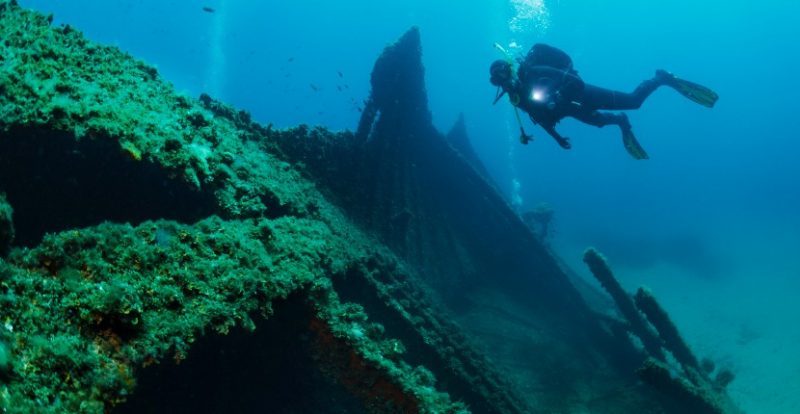A team of marine archaeologists has uncovered a 3,600-year-old shipwreck in the Mediterranean, just off the coast of Antalya, Turkey. The ship, believed to have been a merchant vessel sailing from Cyprus, may be the oldest ever discovered, according to Haaretz.
The wreck was discovered by a team of archaeologists led by Professor Hakan Öniz, from Akdeniz University, Turkey. Based on its position and the large cargo of copper ingots found inside and around the wreck, it is likely to have been a trading ship, ferrying goods from Cyprus to the Aegean region.
Although the ship is in very poor condition, and the hull has been almost completely destroyed, the bulk of the ship, together with its precious cargo, has survived, making this a remarkable and extremely rare find.
3,600-year-old shipwreck found off coast of Turkey: https://t.co/QT73cBD7Q8 pic.twitter.com/KIvRpJ2yFb
— ABC 7 Chicago (@ABC7Chicago) April 10, 2019
According to an article published in the journal Palestine Exploration Quarterly, the team discovered 73 copper ingots inside the wreck. Weighing around 1.5 tons, this immense supply of copper was shaped into “pillow-like” ingots, characteristic of the late Bronze Age. The shape of the ingots allowed Öniz to date the wreckage to before 1400 BC, as from this point onwards, copper was transported as “ox-hide” ingots with a peculiar and distinctive shape.
If correct, this dating means that the ship is the oldest wreck ever to be found in the Mediterranean, even older than the famous Uluburun shipwreck, found near Kas in southwestern Turkey. Although finds have been salvaged from older wrecks off the coast of Greece, this is potentially the oldest wreck where the ship itself, and not simply its contents, has survived.
World’s oldest shipwreck found off Turkey’s Antalya, say officials https://t.co/KtsUP4LFo5 pic.twitter.com/owXq6YnULg
— Hürriyet Daily News (@HDNER) April 10, 2019
According to Öniz, the ship shared the fate of many other Mediterranean vessels in antiquity. In order to facilitate navigation, merchant ships would tend to stay close to the coastline. However, this meant that they could easily be driven onto treacherous coastal rocks, particularly in bad weather. Öniz suggests that it is likely that this ship met with a violent storm, although it may have also been a victim of war or piracy.
Copper was an extremely important and valuable commodity in the Late Bronze Age, and Öniz speculates that the ship could have been travelling to one of a number of destinations in the eastern Mediterranean, including Mycenae, Troy, or other important settlements where copper was in high demand for use in weapons manufacture.
Related Video: Top 10 Famous Shipwrecks Throughout History
https://youtu.be/30mwhnZ2XeI
Other shipwrecks discovered off the coast of Turkey dating to the Late Bronze Age have also been found carrying large amounts of copper, and isotope analysis has shown that it was usually mined on the island of Cyprus. Although the ingots from this latest discovery have not yet been analyzed, it is reasonable, due to its position and the shape of the copper ingots its was carrying, to assume that it too was traveling from Cyprus to other destinations in the Mediterranean.
KICKER: Talk about gone but not forgotten…a merchant ship that sank off Turkey’s Mediterranean Coast has been found. The shipwreck dates back some 3,600 years. A storm likely sunk the ship while it was making a delivery.
IN-176TU pic.twitter.com/dqgk8RxYWt— CNN Newsource (@CNNNewsource) April 10, 2019
In order to avoid any damage to this important and immensely fragile structure, nothing has yet been removed from the site. Instead, according to Haaretz, the team carefully observed and documented the cargo that had been distributed around the site, and then used sonar-scanning technology to study the wreck in detail. The analysis showed that more cargo and part of the ship are buried beneath the seabed, which lies around 50 meters (165 feet) below sea level.
Öniz and his team are excited about the next stages of their research. According to Haaretz, they hope to raise funding that will allow them to excavate parts of the ship and its contents, and use carbon dating techniques to verify its age.
A find of this rarity offers archaeologists a unique insight into Bronze age maritime traditions, commerce and seafaring technology, and therefore has the capacity to tell us a great deal about the people and societies that traversed the Mediterranean in the 16th century BC. One thing is certain – this ancient ship holds many more secrets, just waiting to be discovered.
